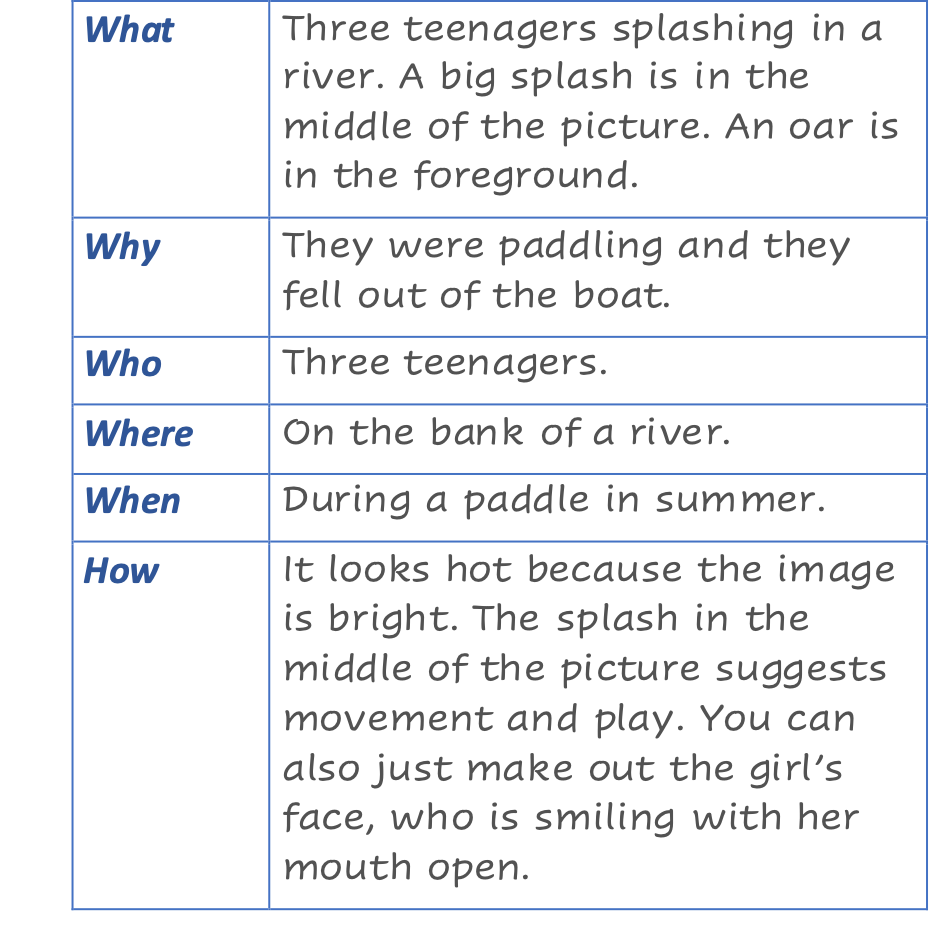When writing about and analysing media artworks, students must describe visual and moving images. To do this, they must create a descriptive text that is sometimes referred to as a word picture.
The two strategies below support students to understand the elements of descriptive language at the word group and paragraph level.
Explicitly teaching expanded noun (or nominal) groups
A noun or nominal group is a group of words that represents or provides information about something (e.g. places, things, ideas) or someone, whether concrete (i.e. physical entity, such as an apple) or abstract (i.e. concept or idea, such as hunger) in a clause.
A noun group can comprise a single word or be expanded to include pre- and/or post-modifiers which provide clear details about the head noun.
In the sentence below, the expanded noun group has been colour coded. The head noun is pink, the pre-modifiers in blue, and the post-modifiers (also called qualifiers) are in yellow.
Physically imposing male
sportsmen
participating in contact sports are often captured in images to reflect particular views about masculinity.
Using expanded noun groups adds description and detailed information. (Compare the above sentence with 'Sportsmen are often captured in images to…..') Teachers can explicitly teach students the components of expanded noun groups to improve their writing.
The example below uses the short film,
Spirit Stones (2014), as a visual text to stimulate student writing.
- The teacher explicitly teaches students the components of expanded noun groups. This can be at either:
- a broad level of pre-modifier + head noun + post-modifier (qualifier)
- in a more detailed way if discussing the order of pre-modifier words. There is an order in which pre-modifier adjectives are listed, that often seems instinctive. The table below outlines the order in which pre-modifiers are usually listed.

- The students watch or view a stimulus (e.g.
Spirit Stones).
- The teacher writes a head noun on the board (e.g. stone) and asks students to add pre- and post-modifiers. Depending on the level of student understanding, and detail in which the teacher has explained the elements of noun groups, the teacher may ask students to re-order pre-modifiers.
For example, the class may write:
The small round pink stone that Eva gives to her grandson …
- Once an expanded noun group has been written, students may be asked to use it in a sentence to describe what the object represents.
The small round pink stone that Eva gives to her grandson represents Indigenous culture.
- Once students understand how to create more detailed word pictures through expanded nominal groups, they can improve their writing when reviewing and editing their work. Students can highlight nouns and add pre- and post-modifiers to create more detailed word pictures of the elements they are describing.
Curriculum links for the above example:
VCAMAR038,
VCAMAR045
Jointly constructed descriptions of photographs
Additionally, teachers might support students to write a description using photos (or stills or short scenes from a film). The following example is adapted from Chong (2017).
- The teacher presents four photographs of an experience. An example image is below.

- The teacher asks students to view the photographs and determine what feeling or emotion the photos generate.
- Students might say: fun, happy, summer, hot
- For the first photograph, the teacher leads a discussion using the
5W and 1H strategy (what, why, who, where, when, and how) to generate a few sentences that describe:
- what is happening in the image
- why it might be happening
- who is in the image
- where the image is taken
- when the image was taken
- how the image relates to or is associated with the feelings and experience.
- Students may use a graphic organizer to record their answers.

- In pairs, students complete the above step for the remaining photographs.
- Students swap their descriptions with another pair and discuss their descriptions, providing feedback to one another based on the descriptions for what, why, who, where, when and how. Students may revise their descriptions. Teachers might provide
a set of sentence stems to help scaffold student talk, such as:
- I like how you …
- Did you consider …
- Did you notice …
- Can you explain …
- I am confused by …
- You might want to add/delete/change …
- The teacher asks students to share their descriptions, writing some on the board and leading a class discussion to show how to link observations (evidence from the photographs) with inferences and interpretations.
Curriculum links for the above example:
VCAMAR038,
VCAMAR045